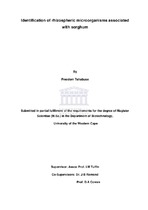| dc.description.abstract | Approximately 50% of sorghum (Sorghum bicolour (L.) Moench) produced globally is used as human food, with 95% of its total consumption occurring in Africa. Unfortunately, sorghum crops are prone to pathogenic attack, notably leading to a reduction in production yields. Generally, chemical agents are used as fertilizers
and/or biocides to increase crop production. However, these chemicals can have a detrimental environmental impact including the eutrophication of fresh water and marine ecosystems. Thus, there is increased interest in plant growth promoting rhizobacteria (PGPR), as an alternative to chemicals, to facilitate eco-friendly biological control of soil-borne pathogens. PGPRs colonize the plant root system (i.e
rhizosphere and rhizoplane) and promote growth and production yields essentially via the biological control of plant pathogens and their role in the nutrient cycles (e.g N fixation). The aim of this study is to characterize the microbial communities associated with sorghum in South Africa, and to identify common bacteria which could further be developed and applied to improve sorghum growth and yield. Sorghum rhizospheric environments (rhizoplane and rhizosphere) were collected from three sites characterized by different agricultural practices (Free State, Limpopo and North West). Denaturing gradient gel electrophoresis (DGGE) and Terminal-restriction fragment length polymorphism (T-RFLP) were used to identify microbial community molecular fingerprints. Sorghum-associated microbial communities were found to be different in all rhizospheric soil samples which could be explained by differences in soil chemistry, agricultural practices and geographical location. The analyses also clearly demonstrated that the sorghum bacterial community structures were similar in the rhizoplane, indicating the strong influence that the sorghum plant has in determining the rhizoplane colonizers. The archaeal community structure from rhizoplane and rhizosphere in each sampling site were dissimilar, which could be explained by differences in soil type and/or agricultural practices. Both the T-RFLP and DGGE analyses revealed that Bacillus sp. were consistently associated with South African Sorghum, Arthrobacter sp. were detected in the rhizoplane, while Uncultured archaea were detected in the rhizoplane of sorghum. These microorganisms represent valuable targets for engineering to promote growth and yield in sorghum. | en_US |

